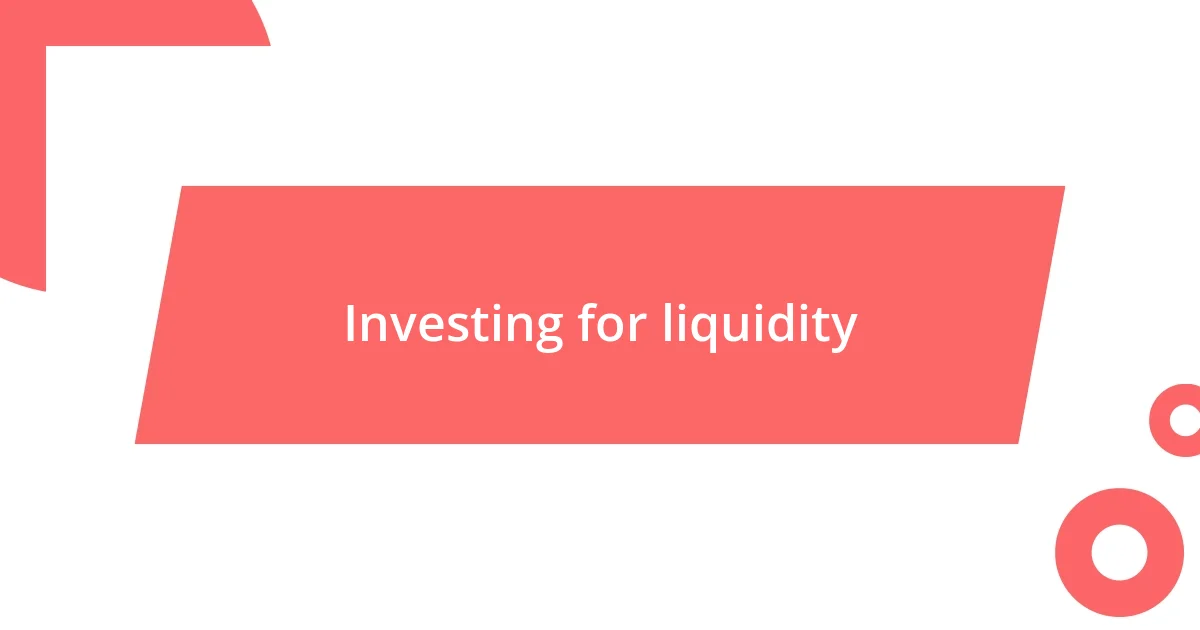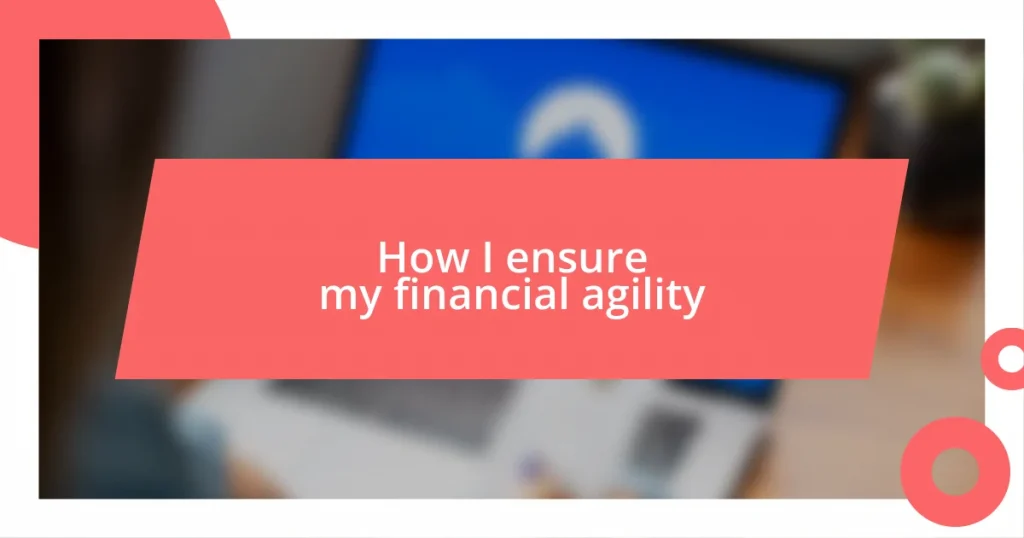Key takeaways:
- Financial agility involves adapting financial plans swiftly to changing circumstances and maintaining a mindset open to uncertainty.
- Setting clear financial goals provides direction, motivation through measurable achievements, and the flexibility to adjust as circumstances change.
- Creating an emergency fund and investing for liquidity empowers individuals to handle unexpected expenses and seize opportunities without financial strain.

Understanding financial agility
Financial agility is the ability to adapt your financial plans and actions swiftly in response to changing circumstances. I remember the time when a sudden job loss hit me; it felt overwhelming at first. But because I had built an agile financial framework, I was able to pivot quickly and assess my options with a clear mind.
It’s not just about having a budget, but about being flexible with it. I often reflect on how my budgeting approach shifted during unexpected life changes—like when my family faced unforeseen medical expenses. That experience taught me the importance of resilience and being ready to adjust my financial priorities without losing sight of my long-term goals.
I often wonder: how prepared are you for financial surprises? The truth is, financial agility comes from both planning and a mindset that embraces uncertainty. By staying informed and open to change, I find I am better equipped to navigate life’s ups and downs.

Importance of financial goals
Setting financial goals is crucial because it provides direction and purpose to our financial decisions. When I established my personal financial goals, I remember the clarity it brought to my spending habits. It felt like having a map in an unfamiliar town; I knew where I wanted to go financially, and from there, every decision became easier.
Moreover, clear financial goals empower us to turn abstract concepts into actionable steps. For instance, when I aimed to pay off debt, I broke it down into smaller targets. Each time I crossed off a debt from my list, I felt a surge of motivation. It’s like celebrating small victories on the path toward a larger dream; these moments keep us focused and engaged.
Finally, having well-defined financial goals helps in assessing progress over time. I often reflect on my goals, adjusting them when necessary. This ongoing evaluation taught me that our aspirations might change, and that’s perfectly okay. In the end, the journey toward financial well-being is dynamic, requiring both intent and adaptability.
| Factor | Importance |
|---|---|
| Clarity | Provides a clear direction for financial decisions. |
| Motivation | Encourages progress through measurable achievements. |
| Flexibility | Allows for adjustments as personal circumstances change. |

Building a flexible budget
Building a flexible budget is like creating a safety net for your financial life. I remember when I first started budgeting; I made a rigid plan that didn’t account for anything unexpected. That led to stress and a feeling of failure when I couldn’t stick to it. Over time, I learned that a flexible budget allows for adjustments—like setting aside money each month for unanticipated expenses or even for fun activities that can uplift your spirits during challenging times.
To establish a flexible budget, I focus on a few key elements:
- Variable Expenses: I allow for fluctuations in categories like groceries or entertainment. This means I can adapt if I have a month where I spend a bit more or less in these areas.
- Emergency Fund: I prioritize building an emergency fund, which acts as a cushion against unforeseen expenses. It’s reassuring to know those funds are there, allowing me to adjust my budget without panic.
- Regular Reviews: Checking in on my budget monthly helps me understand spending patterns and make necessary adjustments. I often find that a particular category needs more attention or that I overestimated my expenses in another.
This process not only provides peace of mind but also fosters a sense of control over my financial journey. Each time I review my budget, I feel empowered to make decisions that align with my values and goals.

Strategies for reducing expenses
Finding ways to reduce expenses can feel like solving a puzzle, and I love a good challenge! One strategy that’s worked wonders for me is the art of meal planning. Before I started this habit, I often found myself splurging on takeout at the end of a long day. Now, I’m much more intentional about what I cook, which not only cuts down my food bill but also encourages a healthier lifestyle. Ever tried it? You’d be surprised how satisfying it is to whip up a creative dish from what you already have at home!
Another method I’ve embraced is evaluating my subscriptions. It amazes me how many services I subscribed to that I barely used! By reviewing my monthly expenses, I identified a couple of streaming services and a fitness app that I’d signed up for with the best intentions but rarely utilized. Canceling them seemed daunting at first, but now it feels liberating every time I see that extra cash in my account. Could you benefit from a little decluttering in your financial life too?
Additionally, I’ve become quite the expert at negotiating bills. I remember the first time I reached out to my internet provider just to ask for a lower rate. I was pleasantly surprised when they offered a discount just for asking! Imagine not having to do anything major—just a quick call, and suddenly more savings appear. It really made me realize that advocating for my own financial health is one of the easiest strategies to employ. Have you considered negotiating your bills? You might find the results are well worth the effort.

Creating an emergency fund
Creating an emergency fund is one of the most empowering steps I’ve taken in my financial journey. I recall a time when my car broke down unexpectedly. Having saved up a decent emergency fund made all the difference—I didn’t need to panic or rely on credit cards. Instead, I felt relief and a sense of control as I used that fund to cover the repair costs without it affecting my regular budget.
To build my emergency fund, I set a target as a priority but kept it realistic. I started small by saving a little each month, often allocating windfalls, like bonuses or tax refunds, directly into that fund. It was exhilarating to see it grow! Have you ever experienced that rush of satisfaction when you reach a savings milestone? Each small contribution felt significant, reinforcing the habit of saving and keeping me motivated for the bigger picture.
I believe that the ideal size of an emergency fund is about three to six months’ worth of living expenses. It might sound daunting, but once I grasped that this fund wasn’t just about having a safety net, but about investing in my peace of mind, it shifted my perspective. I remember vividly how I would calculate my monthly expenses just to see how quickly I could achieve that goal. The journey was as fulfilling as the achievement itself—do you have a vision of what financial safety looks like for you?

Investing for liquidity
Investing for liquidity is a practice that’s really transformed how I manage my finances. I’ve always believed that having access to cash when needed is essential, and keeping a portion of my investments in liquid assets is key. For example, I decided to invest in savings accounts with high interest rates and short-term bonds. This way, I can earn some returns without locking my money away for years. Have you ever thought about how much flexibility you could maintain by choosing the right investment vehicles?
When I first dipped my toes into the world of investing, I was surprised by how many options are out there that cater specifically to liquidity. For instance, I discovered money market funds, which provide decent returns while still allowing me quick access to my cash. This balance between growth and accessibility was what I craved. Have you ever experienced that moment of clarity when you realize an investment fits perfectly into your financial strategy?
I remember vividly a time when an unexpected opportunity arose—a last-minute trip to visit a friend in another state. Thanks to my liquid investments, I could seize that moment without feeling financially strained. That feeling of spontaneity mixed with security was priceless! So, do you have liquid assets that can protect your sense of financial agility? It’s empowering to know that with a smart investment strategy, you can enjoy life’s opportunities as they come.

Monitoring and adjusting financial plans
Monitoring my financial plans has become a routine that I truly value. I often set aside time each month to review my budget and spending. It’s like looking in a mirror—seeing where I’m doing well and where I might be slipping. Isn’t it interesting how a simple check-in can illuminate patterns or habits I hadn’t noticed before?
When I first started to monitor my finances closely, I discovered I had been overspending on dining out. That realization hit me hard, but it also sparked a wave of change. I began cooking more at home, which not only saved money but also brought joy back to my meals. Have you ever found that by adjusting one area of spending, you’ve opened doors to new possibilities?
Adjusting my financial plans isn’t just about cutting back; it’s often about re-evaluating my goals as well. For instance, there was a time when I aimed to save for a large vacation, but then I realized I wanted to invest more in my education. Redirection felt empowering. It’s fascinating how our financial priorities can shift, isn’t it? By staying flexible and attentive, I’m able to mold my plans to match my evolving life circumstances. Don’t you think that’s the key to financial agility?















